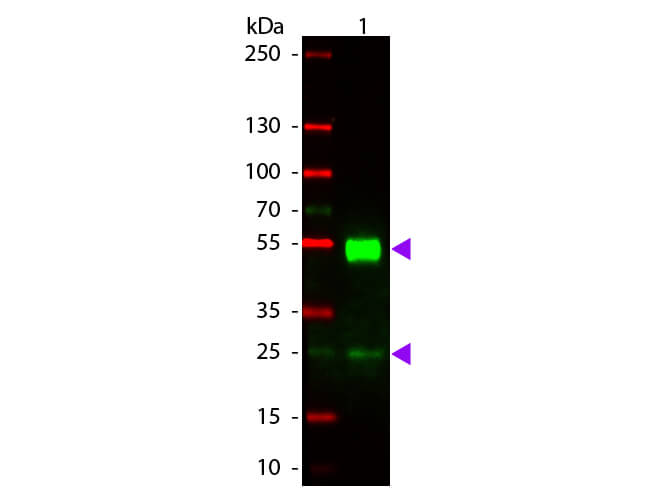Datasheet is currently unavailable. Try again or CONTACT US
Mouse IgG (H&L) Antibody Texas Red™ Conjugated Pre-Adsorbed
Goat Polyclonal
9 References
610-109-121
1 mg
Lyophilized
WB, IHC, IF, Dot Blot
Mouse
Goat
Shipping info:
$50.00 to US & $70.00 to Canada for most products. Final costs are calculated at checkout.
Product Details
Goat Anti-Mouse IgG (H&L) Antibody Texas Red™ Conjugated (Min X Bv Ch Gt GP Ham Hs Hu Rb Rt & Sh Serum Proteins) - 610-109-121
Goat Anti Mouse IgG (H&L) Texas Red™ Conjugated Antibody Pre-Adsorbed, Goat Anti-Mouse IgG Antibody Texas Red™ Conjugation
Goat
IgG (H&L)
Texas Red®
Polyclonal
IgG
Target Details
Mouse
Mouse IgG whole molecule
Mouse IgG (H&L) Antibody Texas Red™ Conjugated Pre-Adsorbed was prepared from monospecific antiserum by immunoaffinity chromatography using Mouse IgG coupled to agarose beads followed by solid phase adsorption(s) to remove any unwanted reactivities. Assay by immunoelectrophoresis resulted in a single precipitin arc against anti-Goat Serum, Mouse IgG and Mouse Serum. No reaction was observed against Bovine, Chicken, Goat, Guinea Pig, Hamster, Horse, Human, Rabbit, Rat and Sheep Serum Proteins.
Application Details
Dot Blot, WB
IF, IHC
- View References
Mouse IgG (H&L) Antibody Texas Red™ Conjugated Pre-Adsorbed antibody has been tested by dot blot and western blot and is designed for immunofluorescence microscopy, fluorescence based plate assays (FLISA) and fluorescent western blotting. This product is also suitable for multiplex analysis, including multicolor imaging, utilizing various commercial platforms.
Formulation
1.0 mg/mL by UV absorbance at 280 nm
0.02 M Potassium Phosphate, 0.15 M Sodium Chloride, pH 7.2
0.01% (w/v) Sodium Azide
10 mg/mL Bovine Serum Albumin (BSA) - Immunoglobulin and Protease free
1.0 mL
Restore with deionized water (or equivalent)
Shipping & Handling
Ambient
Store vial at 4° C prior to restoration. For extended storage aliquot contents and freeze at -20° C or below. Avoid cycles of freezing and thawing. Centrifuge product if not completely clear after standing at room temperature. This product is stable for several weeks at 4° C as an undiluted liquid. Dilute only prior to immediate use.
Expiration date is one (1) year from date of receipt.
Anti-Mouse IgG Texas Red Antibody generated in goat detects reactivity to Mouse IgG. Secreted as part of the adaptive immune response by plasma B cells, immunoglobulin G constitutes 75% of serum immunoglobulins. Immunoglobulin G binds to viruses, bacteria, as well as fungi and facilitates their destruction or neutralization via agglutination (and thereby immobilizing them), activation of the compliment cascade, and opsonization for phagocytosis. The whole IgG molecule possesses both the F(c) region, recognized by high-affinity Fc receptor proteins, as well as the F(ab) region possessing the epitope-recognition site. Both the Heavy and Light chains of the antibody molecule are present. Secondary Antibodies are available in a variety of formats and conjugate types. When choosing a secondary antibody product, consideration must be given to species and immunoglobulin specificity, conjugate type, fragment and chain specificity, level of cross-reactivity, and host-species source and fragment composition.
Murillo-Pineda M et al. (2021). Induction of spontaneous human neocentromere formation and long-term maturation. J Cell Biol.
Applications
IF, Confocal Microscopy
Yingling CV et al. (2021). FHOD formin and SRF promote post-embryonic striated muscle growth through separate pathways in C. elegans. Exp Cell Res.
Applications
IF, Confocal Microscopy
Chaillou T et al. (2016). Expression of Muscle‐Specific Ribosomal Protein L3‐Like Impairs Myotube Growth. J Cell Physiol.
Applications
IHC, ICC, Histology
Fry et al. (2015). Inducible depletion of satellite cells in adult, sedentary mice impairs muscle regenerative capacity without affecting sarcopenia. Nature Medicine
Applications
IHC, ICC, Histology
Fry CS et al. (2014). Regulation of the muscle fiber micro environment by activated satellite cells during hypertrophy. FASEB J.
Applications
IHC, ICC, Histology; WB, IB, PCA
Mula J et al. (2013). Automated image analysis of skeletal muscle fiber cross-sectional area. J Appl Physiol (1985).
Applications
IHC, ICC, Histology
Liu F et al. (2013). Automated fiber-type-specific cross-sectional area assessment and myonuclei counting in skeletal muscle. J Appl Physiol (1985).
Applications
IHC, ICC, Histology
McCarthy JJ et al. (2011). Effective fiber hypertrophy in satellite cell-depleted skeletal muscle. Development.
Applications
IHC, ICC, Histology; WB, IB, PCA
Jan Aten et al. (2000). Strong and selective glomerular localization of CD134 ligand and TNF receptor-1 in proliferative lupus nephritis. J Am Soc Nephrol.
Applications
Confocal Laser Scanning Microscopy (CLSM)
This product is for research use only and is not intended for therapeutic or diagnostic applications. Please contact a technical service representative for more information. All products of animal origin manufactured by Rockland Immunochemicals are derived from starting materials of North American origin. Collection was performed in United States Department of Agriculture (USDA) inspected facilities and all materials have been inspected and certified to be free of disease and suitable for exportation. All properties listed are typical characteristics and are not specifications. All suggestions and data are offered in good faith but without guarantee as conditions and methods of use of our products are beyond our control. All claims must be made within 30 days following the date of delivery. The prospective user must determine the suitability of our materials before adopting them on a commercial scale. Suggested uses of our products are not recommendations to use our products in violation of any patent or as a license under any patent of Rockland Immunochemicals, Inc. If you require a commercial license to use this material and do not have one, then return this material, unopened to: Rockland Inc., P.O. BOX 5199, Limerick, Pennsylvania, USA.




